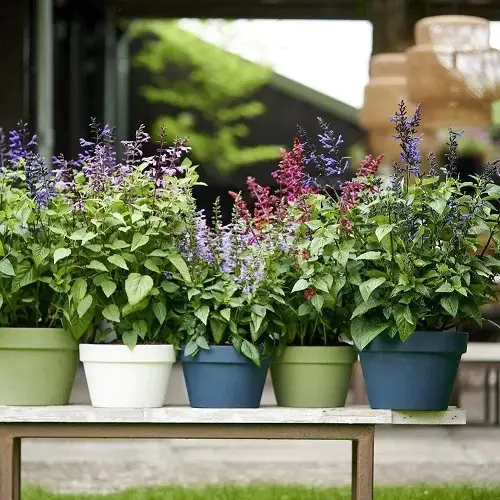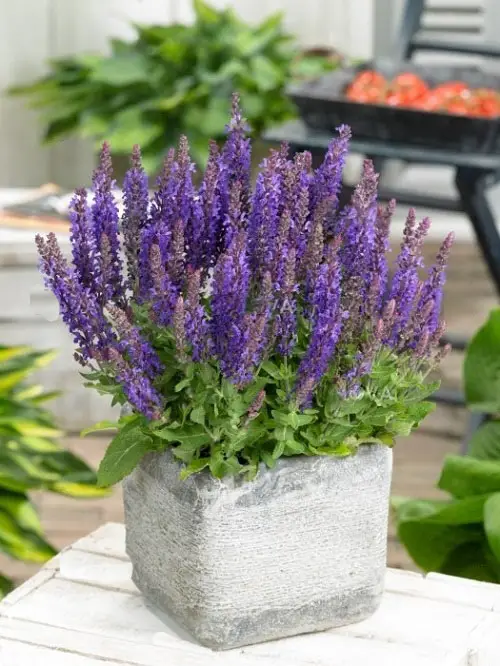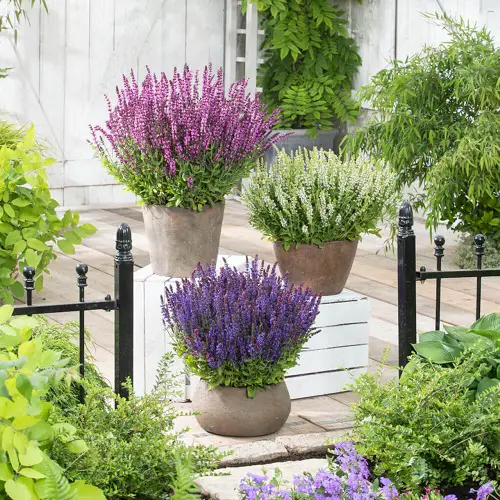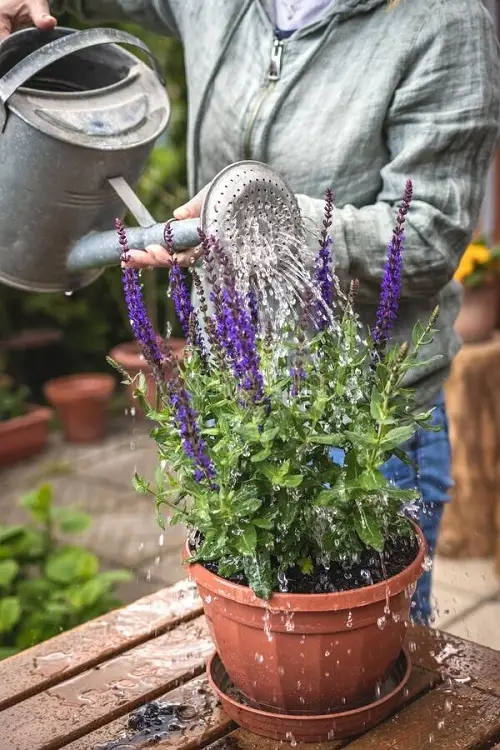Planning about Growing Salvias in Pots? This guide will give you a complete tour about its requirements and care!
Growing Salvias in Pots can be a great way to add vibrant color and texture to your patio, balcony, or indoor space. These plants are relatively easy to grow and care for, making them an ideal choice for container gardening.
Salvia Plant Information

Salvias are flowering plants in the mint family – Lamiaceae, that include numerous species. The plants are native to Central and South America, Mexico, parts of Asia, and the Mediterranean region.
Salvias are popular for their vibrant flowers that bloom in shades of blue, purple, red, pink, and white. Many species of salvias are also famous for their aromatic foliage, which people use in herbal medicine and culinary applications.
In addition to their ornamental and medicinal uses, salvias are also a great choice for attracting pollinators such as bees, butterflies, and hummingbirds to the garden.
Propagating Salvia Plant
You can easily propagate salvias using seeds and cuttings.
Through Cuttings:
- Select a healthy salvia plant and choose a non-flowering stem that is about 3-4 inches long.
- Use a sharp pair of pruning shears or scissors to cut the stem just below a node (where the leaves attach to the stem).
- Remove the lower leaves from the stem, leaving only the top 1-2 pairs of leaves.
- Dip the cut end of the stem into a rooting hormone powder or gel, which will help promote the growth of roots.
- Plant the cutting in a well-draining potting mix or a mixture of perlite and peat moss.
- Water the cutting and place it in a bright, warm location, out of direct sunlight. Keep the soil moist but not waterlogged.
- After a few weeks, the cutting will start to produce new growth.
Through Seeds:
- Collect mature seeds from a healthy Salvia plant.
- Clean the seeds by removing any debris or chaff, and allow them to dry out completely.
- Fill a seed tray or small pots with a good quality seed starting mix.
- Plant the Salvia seeds 1/2 inch deep in the seed starting mix.
- Water the seeds gently, being careful not to disturb the soil or displace the seeds.
- Cover the seed tray or pots with a clear plastic cover or plastic wrap to create a mini greenhouse effect that will help retain moisture and warmth.
- Place the seed tray or pots in a warm and well-lit location, such as a windowsill or under grow lights.
- Check the seed tray or pots regularly and water as needed to keep the soil moist but not waterlogged.
- Once the seedlings have emerged and have grown their first set of true leaves, they can be transplanted into larger pots.
Growing Salvias in Pots
You can start the plant in an 8-10 inch container, which will be good enough for 1-2 years. depending on the growth and spread of the plant, keep on re-potting it into one size bigger container than the old one.
When selecting a container type, look for pots made from materials such as plastic, ceramic, or clay. Avoid using metal pots, as these can heat up quickly in the sun and damage the roots of the plant. Make sure the pot has drainage holes in the bottom to allow excess water to drain away, as Salvia plants do not like to be waterlogged.
Requirements for Growing Salvias in Pots
Location
Salvia plants prefer full sun to partial shade, with at least 5-6 hours of direct sunlight daily. These plants can tolerate some shade, but too much shade can cause the plants to become leggy and less productive.
If you’re growing Salvia indoors, place the plant near a bright window – an east-facing one would be a great choice!
These flowers prefer well-draining soil that is rich in organic matter. The soil should be loose and crumbly and should not become waterlogged after watering.
The ideal soil pH for Salvia plants is between 6.0 and 8.0, but they can tolerate a wider range of soil pH levels.
Water
Salvia plants prefer regular watering but should not be allowed to become waterlogged or completely dry out. Water the plants deeply when the topsoil feels a little dry to the touch.
When watering, avoid getting water on the leaves or blooms, as this can encourage the growth of fungal diseases.
Temperature and Humidity
Salvia plants are generally hardy and can tolerate a wide range of temperatures, but they prefer warm temperatures between 60-80°F (15-27°C).
During periods of extreme heat or cold, they may require additional protection, such as shade cloth or frost blankets. These flowers prefer low to moderate humidity levels and may develop fungal diseases if the air is too humid.
Growing Salvias in Pots – Care
Fertilizing
Salvia plants benefit from regular fertilization to encourage healthy growth and blooming. A 10-10-10 liquid blend is a good choice. Feed the plant once in 4-6 weeks after diluting the fertilizer to 1/2 of its strength.
Do not feed the plant in colder months.
Pests and Diseases
These beautiful flowers are generally hardy and relatively pest-free, but they can be susceptible to certain pests and diseases.
Spider mites, aphids, and whiteflies are some common pests that can affect the growth. These tiny pests can cause damage to the leaves, causing them to turn yellow or brown, and can be controlled with insecticidal soap or neem oil.
Fungal diseases like powdery mildew can be prevented by providing good air circulation around the plants and avoiding overhead watering. In addition to this, root rot can be caused by overwatering or poor soil drainage.
Diseases like leaf spots can cause dark spots to develop on the leaves. It can be prevented by providing good air circulation around the plants and avoiding overhead watering.






